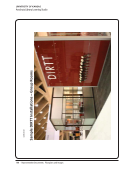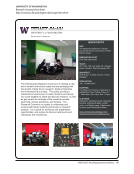56 · Survey Results: Survey Questions and Responses
New opportunity for support staff, upgraded positions. Librarians are more actively involved as models and mentors to
desk staff. Some renovations to accommodate the single desk area improved physical aspects.
Not having circulation services allows much more time to deal with other services. There are fewer interruptions. Unlike
circulation transactions, consultation &teaching time can be scheduled. “Business” was cut in half allowing time to
produce a well-received newsletter. Not having technical services functions also contributed to freeing up time even
though the circulation and tech staff was moved elsewhere. Moving the collection presented an opportunity to weed
duplicates and materials no longer deemed valuable.
Our single service point resulted in overall improved customer service. Why? Allowed us to provide consistent training
for all frontline service desk staff thanks to merging of circulation and reference units and reallocation of duties of third
unit (taking ILS off service desk). Frontline services now completely focused on immediate user needs with removal of
processing from “on-stage” to “backstage”. This has allowed for better customer focus at the desk and more accurate
and efficient processing procedures off desk. More desirable first floor space available for student learning and public
use.
Primary benefit is expected to be cost savings that will be used to meet budget cuts for 2011–12 and subsequently
reduced base budget. Operating efficiencies will also permit re-allocation of resources toward growth of e-science
programs.
Reduced staff costs. Reduced facilities costs. Staff available to be reassigned to other areas.
Reduced student labor costs. More robust e-journal collection.
Savings in our casual-hourly budget for student employees. Ability to reassign permanent staff. Greater convenience for
users (“one-stop-shopping” for multiple formats).
Space where the reference desk previously stood has been reconfigured for use by students and other users. Since staff
are cross trained, we have a more flexible workforce.
Staff working across library service points are familiar with the collections and services offered across one or more
locations and disciplines, making them better able to support interdisciplinary research. There is more of a focus on the
integration of both physical and virtual service points, and providing a consistent user experience across the multiple
channels that users take to contact the Libraries. The organization is poised to be opportunistic and act more quickly
on emerging service priorities from the community, which we will learn about through ethnographic studies, usability
studies, and other channels for patron feedback. Delivery times for access to content should be improved, and options
for access to materials via traditional interlibrary loan, paging services, and direct borrowing arrangements can be
simplified and consolidated.
Students using the facility who never used library. Better connections with staff in Student and Enrollment Services who
will be collaborating more with us as they move into the Student Success Centre. More opportunities to take advantage
of new media in the production of new knowledge.
The change resulted in a reduction of staff (retiring staff member not replaced) and required fewer student employees.
Two full-time staff positions could be redeployed to areas of greater need. Media/audiovisual materials in the collection
were presented to users in a more visible and integrated way.
We anticipate users will be better served because they will be able to handle routine questions more quickly at service
points.
We have not done a formal assessment, but user response has been positive because non-returnables can be picked up
whenever the library is open. Unexpectedly, the staff like their new location better than their old. It’s all about windows.
New opportunity for support staff, upgraded positions. Librarians are more actively involved as models and mentors to
desk staff. Some renovations to accommodate the single desk area improved physical aspects.
Not having circulation services allows much more time to deal with other services. There are fewer interruptions. Unlike
circulation transactions, consultation &teaching time can be scheduled. “Business” was cut in half allowing time to
produce a well-received newsletter. Not having technical services functions also contributed to freeing up time even
though the circulation and tech staff was moved elsewhere. Moving the collection presented an opportunity to weed
duplicates and materials no longer deemed valuable.
Our single service point resulted in overall improved customer service. Why? Allowed us to provide consistent training
for all frontline service desk staff thanks to merging of circulation and reference units and reallocation of duties of third
unit (taking ILS off service desk). Frontline services now completely focused on immediate user needs with removal of
processing from “on-stage” to “backstage”. This has allowed for better customer focus at the desk and more accurate
and efficient processing procedures off desk. More desirable first floor space available for student learning and public
use.
Primary benefit is expected to be cost savings that will be used to meet budget cuts for 2011–12 and subsequently
reduced base budget. Operating efficiencies will also permit re-allocation of resources toward growth of e-science
programs.
Reduced staff costs. Reduced facilities costs. Staff available to be reassigned to other areas.
Reduced student labor costs. More robust e-journal collection.
Savings in our casual-hourly budget for student employees. Ability to reassign permanent staff. Greater convenience for
users (“one-stop-shopping” for multiple formats).
Space where the reference desk previously stood has been reconfigured for use by students and other users. Since staff
are cross trained, we have a more flexible workforce.
Staff working across library service points are familiar with the collections and services offered across one or more
locations and disciplines, making them better able to support interdisciplinary research. There is more of a focus on the
integration of both physical and virtual service points, and providing a consistent user experience across the multiple
channels that users take to contact the Libraries. The organization is poised to be opportunistic and act more quickly
on emerging service priorities from the community, which we will learn about through ethnographic studies, usability
studies, and other channels for patron feedback. Delivery times for access to content should be improved, and options
for access to materials via traditional interlibrary loan, paging services, and direct borrowing arrangements can be
simplified and consolidated.
Students using the facility who never used library. Better connections with staff in Student and Enrollment Services who
will be collaborating more with us as they move into the Student Success Centre. More opportunities to take advantage
of new media in the production of new knowledge.
The change resulted in a reduction of staff (retiring staff member not replaced) and required fewer student employees.
Two full-time staff positions could be redeployed to areas of greater need. Media/audiovisual materials in the collection
were presented to users in a more visible and integrated way.
We anticipate users will be better served because they will be able to handle routine questions more quickly at service
points.
We have not done a formal assessment, but user response has been positive because non-returnables can be picked up
whenever the library is open. Unexpectedly, the staff like their new location better than their old. It’s all about windows.






















































































































































































































